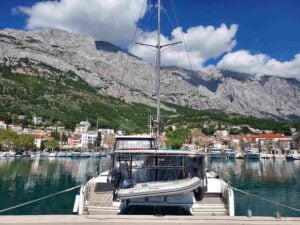In our last blog about our sailing adventures, we talked about sailing the Northwest coast of Spain: from Bilbao to Muxia. Our next hop along the west coast of Spain would turn out to be interesting one with a contradictory combination: we sailed into one of the most dangerous parts of the Spanish coast, directly followed by one of the most serene parts! How is that possible?
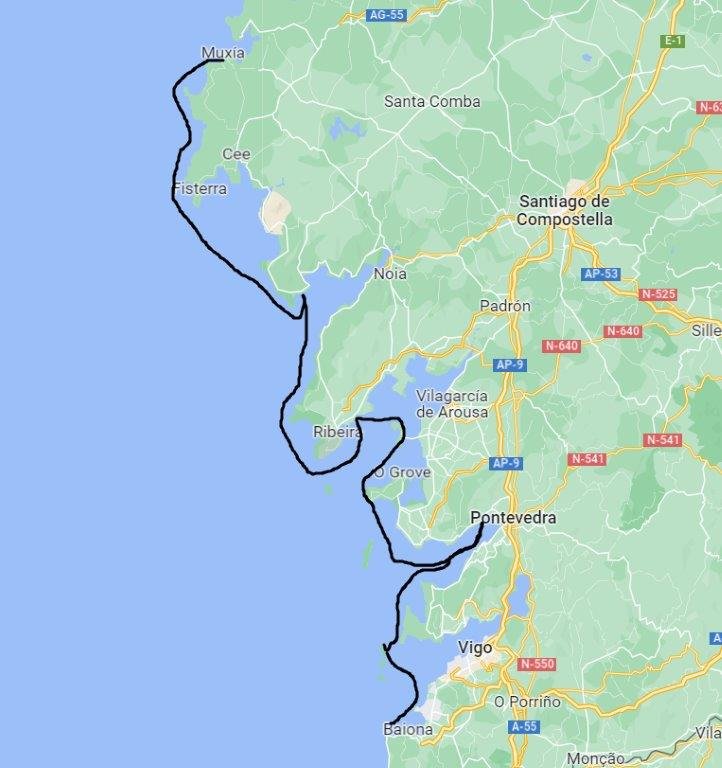
Costa da Morte
Well, the turning point from the northside of Spain to the westside of Spain, means crossing from the Bay of Biscay into the open Atlantic Ocean. Technically, The Bay of Biscay is also Atlantic Ocean water, but it is more protected by land. So this switch around the corner means a lot changes: jagged rocky coasts, shallow waters, cliffs, sudden persistent fog, strong currents. . . . That’s why this area is called la Costa da Morte (‘The Coast of Death’). It didn’t get its name just like that.
More than a hundred ships have sunk here since the 19th century. There are many reefs along the coast line and rocks just under the waterline. You really have to plan your route carefully. Evil tongues claim that some disasters in the 19th century could have been prevented if the coastal inhabitants had not lit fires to lure the ships seeking a safe haven to shore.

We started from Muxia, sailing along the coastline described above and we regularly see the ocean swells break up on the steep cliffs. We also notice that the sea becomes very restless in some places. Depth appears to decrease quickly from 100 to 50 meters and sometimes to 30 meters. This sometimes makes it quite uncomfortable to sail. On some stretches, Gilles takes over from the autopilot to better navigate the waves.
Killer whales
Another concern in this area is orca’s attacking sailboats: they dive under the boat, chew on the rudders and bang the bottom. It can go on for hours…. These orca’s are a group of 5 families, with 50 animals in total. They have attacked about 250 boats in the last 2 years. No one understands why they do this: playing, curiosity, hungry or defending their territory and fish? This is a video of orca’s attacking a catamaran in October 2020. The sound of bashing the bottom of the boat is horrible.
The attacks started in the south of Portugal 2 years ago and the orca’s are migrating to the north in pursuit of the bluefin tuna. They are now (Sept 2022) near the north-west tip of Spain and expected to move north along the Bay of Biscay, but when is unpredictable.
We heard from fellow sailors this month that several attacks happened here this summer and even the harbormaster mentioned he had a boat last week with damage because of orca’s.
To avoid these attacks, the advice is to sail close to the coast (remember the reefs in this area…?). When an attack happens, start the engines because in case of a catamaran, the propeller protects the rudder and get to a harbor with shallow water as quickly as possible. The result of the attack is usually a broken rudder and after the attacks, when you are still in open waters, you need to be towed by the coastguard into a harbor. Seems traumatic to us. Luckily we were not attacked and passed this area safely.
Maybe they sold sell T-shirts in the harbors in this area, saying:
‘I sailed and survived Costa da Morte (and the orca’s)’
Ria’s: the fjords of Spain
And after the intensive Costa da Morte, you’ll experience the biggest contrast you can imagine, because you end up in one of the most lovely, serene and quite area: the Ria’s Biax. These are a group of 4 fjords in Spain. Officially, they are not fjords, because the fjords in Norway are eroded when the glaciers from the inland made their way to the sea. And these Ria’s are coves created by erosion of the ocean waters from the outside going inland. But still, the atmosphere is quite the same. You sail into an tranquil area with on both sides mountains with lots of trees. And unlike Norwegian fjords, here you have white beaches, 28 degrees and sangria 😉!
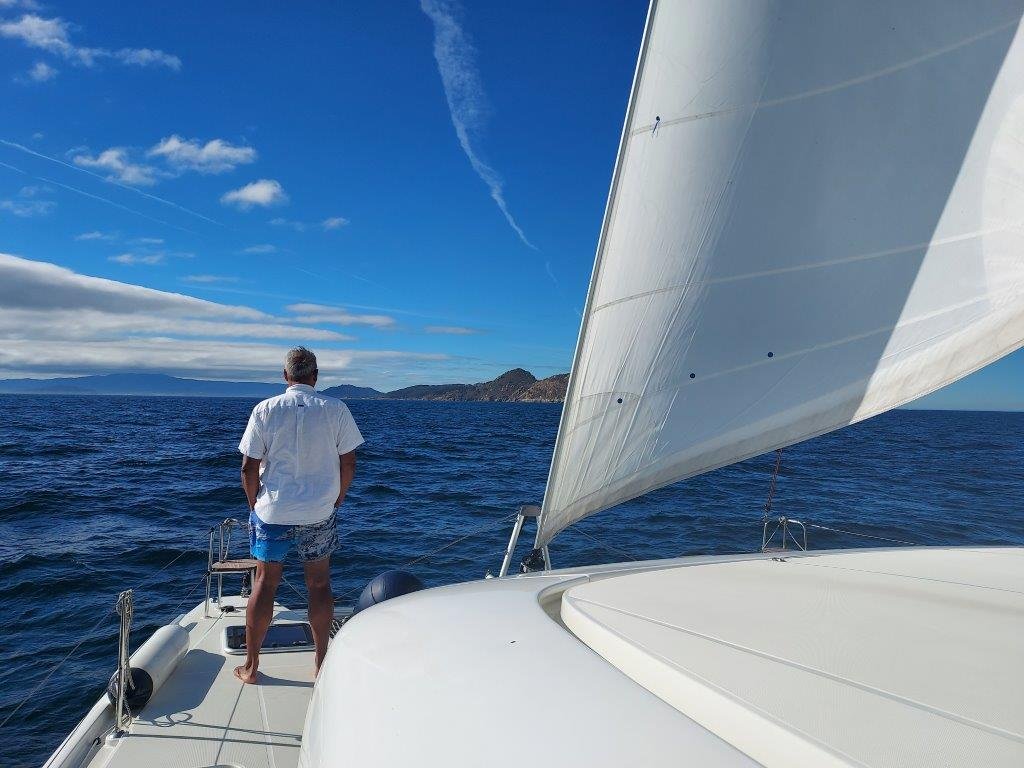


We have visited all 4 Ria’s and like to describe the highlights.
- Ria de Muros
We stayed in the harbor of Muros, a lovely place at the entrance of the estuary. A lot of fisherboats here and white stone houses with arcades and cozy terraces. We decided to take a seat at one of the terraces, but we make the mistake (again!) of not noticing the Spanish eating times. From 13.00-15.00h they take a warm lunch, from 17.00h a small snack and from 21.00h dinner. So when we wanted a drink and some tapas around 16.00h, they told us they closed the kitchen. Luckily, one bar welcomed us and we had great tapas with local Galician cider. My favorite tapas are the green peppers (Pimientos de Padrón), prawns (camarones) and calamaris (pulpo).
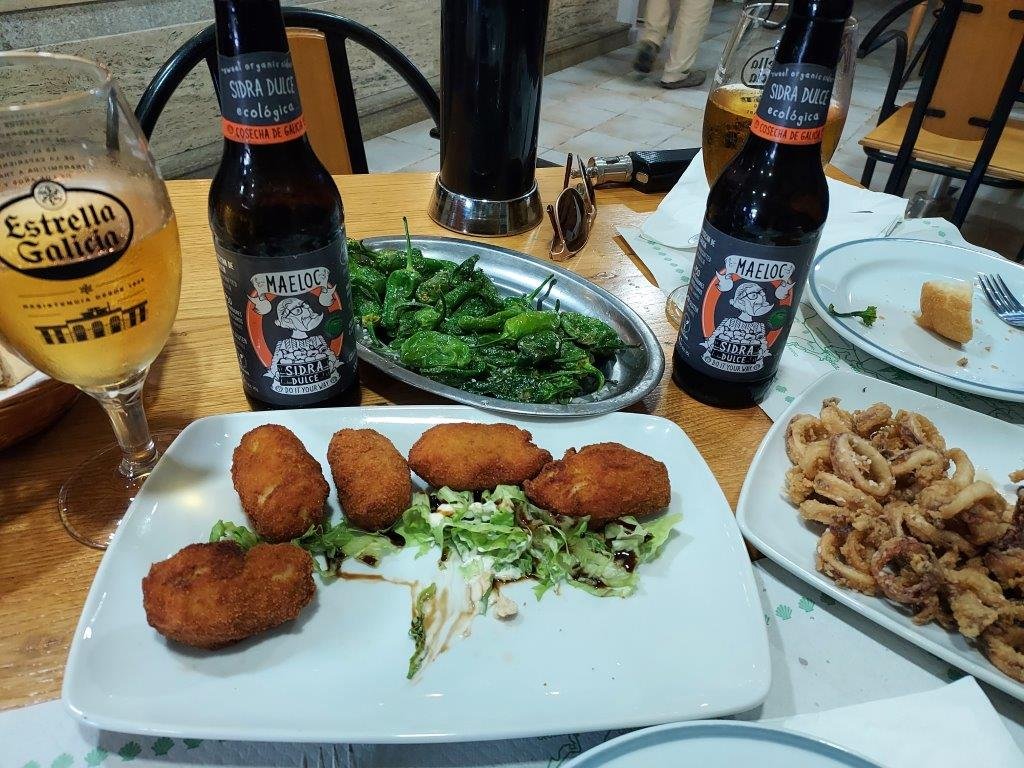


We visited the markethall and talked to Dutch fellow-sailors Robert and Anneke Hol and their 3 childern. They came from the Azores and had sailed in the Ria’s before. They mentioned their website which had some great advice!
2. Ria de Arousa
This is the largest Ria and has a lot of musselfarms, floating on the water. Closeby the musselfarms, we noticed black fins sticking out of the water, so Gilles joked: ‘Maybe it’s baby orca’s!’. Luckily, it turned out to be dolphins swimming around, eating the seafood.



It’s interesting to see how the fishermen in the Ria’s do their fishing in this area on their little boats. The Atlantic Ocean is only 3 meters deep here, close to the coast. So from their boats, they scrape with an iron basket over the seabed. The basket is attached to a long wooden stick. This way they hope to bring out shellfish like mussels and earn their wages again that day. I made a video in the morning standing on the bow of our ship when we passed by these fishermen:
We stayed at anchor in a bay in Ria de Arousa and even spotted the Finish catamaran again, called ‘Balance3’. We first met them at A Coruna and they also plan to sail the Ria’s and then the Portuguese westcoast.
3. Ria de Pontevedra
This is our favorite Ria! We anchored at such a lovely bay and had a good time paddleboarding along the beach and watching all the people at the beach relaxing, having BBQ with their families at the nearby camping place.
The island of Tambo in the middle of the Ria is a beautiful small island and Combarro is a special Medieval village. We enjoyed walking in this authentic village which is known for 2 things: stone granaries that were built to store grain and fish and are build upon piles, so the rats and mice can’t climb inside.

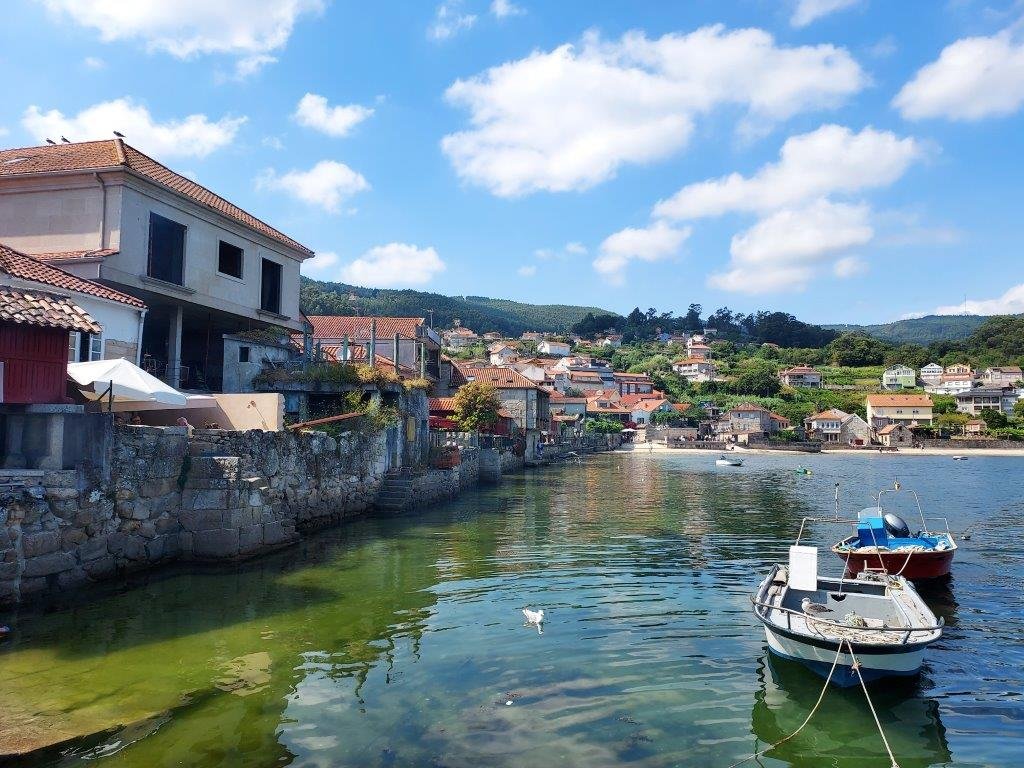

And the other famous feature in Combarro are crucifixes standing on a raise. You’ll find them on busy intersections in the village. This has to do with the Legend of Santa Compaña.
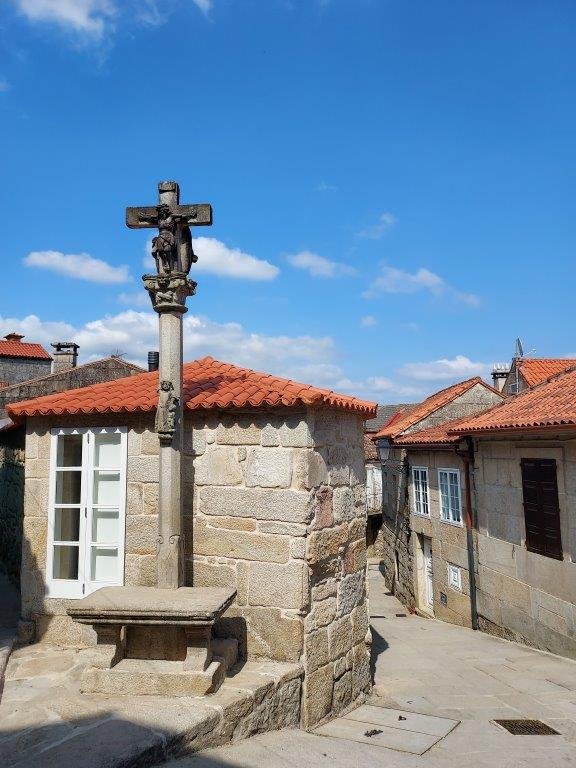
The Legend of Santa Compaña
After midnight, a group of rags, ghostly figures barefooted and with a candle in their hand, wander in misty realms. With a guide. When you see them you have (less than) a year to live. The guide is a living person, but no less sinister. He or she looks white, gaunt, mutters prayers and carries a cross. The only nice thing about the guide is that he or she has a bell, so you can hear the parade coming. The only way to get rid of the dreadful task of being the guide is to hand the cross over to another living person….. But luckily you can protect yourself. When you meet them, draw a circle on the ground with a cross in it. If you stand in it, nothing will happen to you and the guide will not be able to hand you the cross. And there is another effective way to escape the fatal outcome of an encounter with the Santa Compaña. Those are the stone cruceiros, you should climb upon the raise of the cross posts and you are safe.
The legend of the Santa Compaña is something you shouldn’t joke about. Galician people always know someone who has seen the scary pageant or they have seen it themselves.
4. Ria de Vigo
Back to sailing the Ria’s! In front of the last Ria, there are the Cies islands. Really beautiful islands with pearly white beaches surrounded by crystal clear water with enough turquoise to feel like you are on an exotic island. A little bit of the Tropics in Northern Spain!

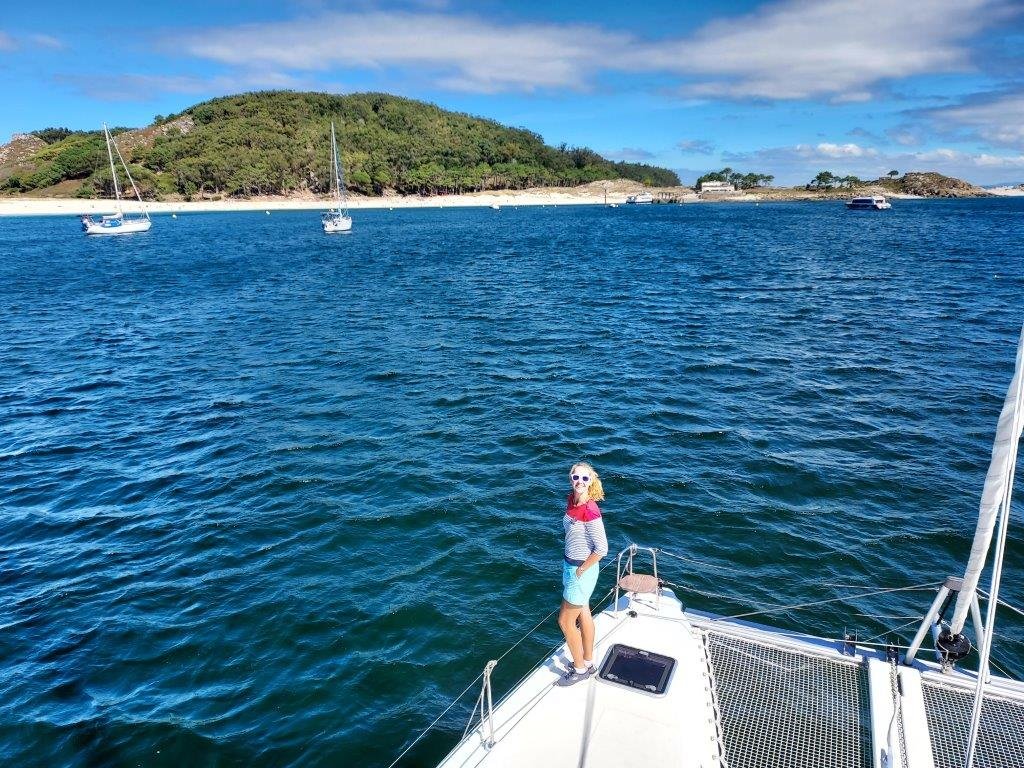

We stayed at anchor at Playa de Rodas, which was voted the most beautiful beach in the world in 2007. We understand why! We made a video with our drone, flying above the beach and the boats at anchor:
After this great time at the Ria’s with lots of sunshine and 5 days in a row anchoring, we said goodbye to Spain. We had been for 2 months in this northern part of Spain and now it’s time to cross the border to…..Portugal!


